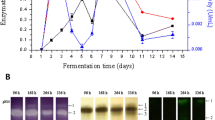Abstract
Sugarcane bagasse is an agroindustrial residue generated in large amounts in Brazil. This biomass can be used for the production of cellulases, aiming at their use in second-generation processes for bioethanol production. Therefore, this work reports the ability of a fungal strain, Trichoderma harzianum IOC-4038, to produce cellulases on a novel material, xylan free and cellulose rich, generated from sugarcane bagasse, named partially delignified cellulignin. The extract produced by T. harzianum under submerged conditions reached 745, 97, and 559 U L−1 of β-glucosidase, FPase, and endoglucanase activities, respectively. The partial characterization of this enzyme complex indicated, using a dual analysis, that the optimal pH values for the biocatalysis ranged from 4.9 to 5.2 and optimal temperatures were between 47 and 54 °C, depending on the activity studied. Thermal stability analyses revealed no significant decrease in activity at 37 °C during 23 h of incubation. When compared to model strains, Aspergillus niger ATCC-16404 and Trichoderma reesei RutC30, T. harzianum fermentation was faster and its extract showed a better balanced enzyme complex, with adequate characteristics for its application in simultaneous saccharification and fermentation processes.




Similar content being viewed by others
References
Pessoa, A., Jr., Roberto, I. C., Menossi, M., Santos, R. R., Ortega Filho, S., & Penna, T. C. V. (2005). Applied Biochemistry and Biotechnology, 121–124, 59–70.
FAOSTAT 2009. Available from: http://faostat.fao.org. Accessed November 2, 2009.
FIESP/CIESP 2001. Available from: www.fiesp.com.br/publicacoes/pdf/ambiente/relatorio_dma.pdf. Accessed November 2, 2009.
Wilson, D. B., & Irwin, D. C. (1999). Advances in Biochemical Engineering/Biotechnology, 65, 1–21.
Lynd, L. R., Weimer, P. J., Van Zyl, W. H., & Pretorius, I. S. (2002). Microbiology and Molecular Biology Reviews, 66, 506–577.
Juhász, T., Egyházi, A., & Réczey, K. (2005). Applied Biochemistry and Biotechnology, 121–124, 243–254.
Tsao, G. T., Xia, L., Cao, N., & Gong, C. S. (2000). Applied Biochemistry and Biotechnology, 84–86, 743–749.
García-Kirchner, O., Segura-Granados, M., & Rodríguez-Pascual, P. (2005). Applied Biochemistry and Biotechnology, 121–124, 347–359.
Wen, Z., Liao, W., & Chen, S. (2005). Applied Biochemistry and Biotechnology, 121–124, 93–104.
Massadeh, M. I., Yusoff, W. M. W., Omar, O., & Kader, J. (2001). Biotechnological Letters, 23, 1771–1774.
Castro, A. M. (2006). MSc dissertation, Federal University of Rio de Janeiro, Rio de Janeiro, Brazil.
Castro, A. M., Carvalho, M. L. A., Leite, S. G. F., & Pereira, N., Jr. (2010). Journal of Industrial Microbiology & Biotechnology, 37, 151–158.
Szijartó, N., Szengyel, Z., Lidén, G., & Réczey, K. (2004). Applied Biochemistry and Biotechnology, 113–116, 115–124.
Ghose, T. K. (1987). Pure and Applied Chemistry, 59, 257–268.
Miller, G. L. (1959). Analytical Chemistry, 31, 426–428.
Bailey, M. J., Biely, P., & Poutanen, K. (1992). Journal of Biotechnology, 23, 257–270.
Charney, J., & Tomarelli, R. M. (1947). The Journal of Biological Chemistry, 171, 501–505.
Bradford, M. M. (1976). Analytical Biochemistry, 72, 248–254.
Ahmed, S., Aalam, N., Latif, F., Rajoka, M. I., & Jamil, A. (2005). Frontiers in Natural Product Chemistry, 1, 73–75.
Wingren, A., Galbe, M., & Zacchi, G. (2003). Biotechnology Progress, 19, 1109–1117.
Vazquez, M. P., Silva, J. N., Souza, M. B., Jr., & Pereira, N., Jr. (2007). Applied Biochemistry and Biotechnology, 136–140, 141–153.
Ferreira, V., Faber, M. O., Mesquita, S. S., & Pereira, N., Jr. (2010). Electronic Journal of Biotechnology, 13, 1–7.
Iwashita, K., Shimoi, H., & Ito, K. (2001). Journal of Bioscience and Bioengineering, 91, 134–140.
Lima, A. L. G., Nascimento, R. P., Bon, E. P. S., & Coelho, R. R. R. (2005). Enzyme and Microbial Technology, 37, 272–277.
Akiba, S., Kimura, Y., Yamamoto, K., & Kumagai, H. (1995). Journal of Fermentation and Bioengineering, 79, 125–130.
Vries, R. P., & Visser, J. (2001). Microbiology and Molecular Biology Reviews, 65, 497–522.
Berlin, A., Gilkes, N., Kilburn, D., Bura, R., Markov, A., Skomarovsky, A., et al. (2005). Enzyme and Microbial Technology, 37, 175–184.
Acknowledgments
Thanks to Daniele F. Carvalho and Marcelle L. A. Carvalho for their technical support. The authors also thank PETROBRAS, the Brazilian Council for Research (CNPq), and the Rio de Janeiro State Foundation for Science and Technology (FAPERJ) for their financial support.
Author information
Authors and Affiliations
Corresponding author
Rights and permissions
About this article
Cite this article
de Castro, A.M., Pedro, K.C.N.R., da Cruz, J.C. et al. Trichoderma harzianum IOC-4038: A Promising Strain for the Production of a Cellulolytic Complex with Significant β-Glucosidase Activity from Sugarcane Bagasse Cellulignin. Appl Biochem Biotechnol 162, 2111–2122 (2010). https://doi.org/10.1007/s12010-010-8986-0
Received:
Accepted:
Published:
Issue Date:
DOI: https://doi.org/10.1007/s12010-010-8986-0




